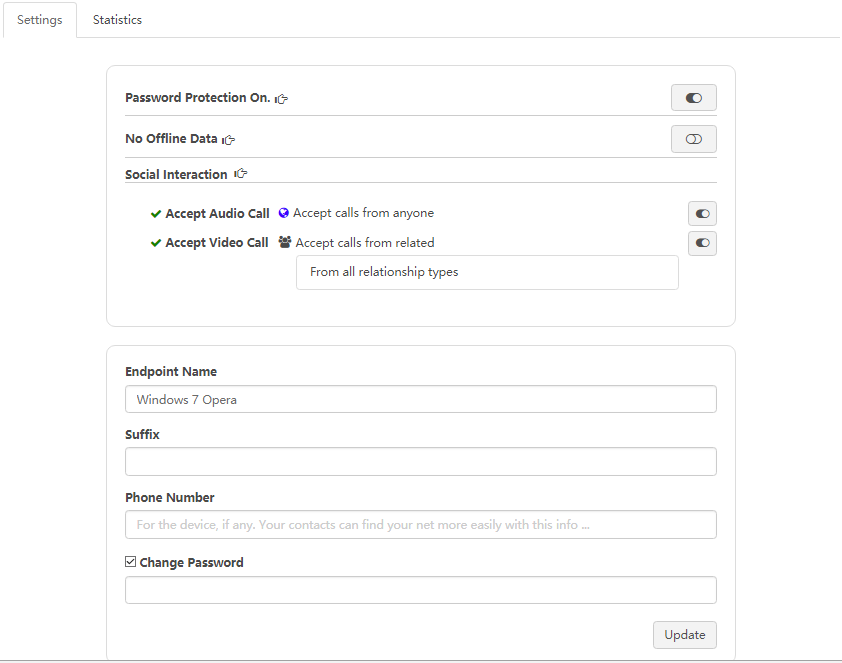Endpoint Settings Page
Shown inside of the dark strip under the main menu are the full name of the corresponding endpoint and its GUID.
A Sample View
The figure next contains a list of toggle buttons and a change password text box outside of the red rectangular that are used to changes the behaviors of the endpoint and the corresponding current state of such a behavior.
The area inside of the red box contains a few text boxes used to change different components of the full name of the endpoint.
Page Components
Behavior Settings
This part is only available only when the settings for the current endpoint itself to be changed.
-
Check App Updates: Check for possible V-NET APP or desktop program updates manually. The system checks updates automatically when the client is starting, therefore manual checking is not required in normal cases.
This feature is only available to APP or desktop clients of V-NET.
-
Remote Control Disabled: Remote control is not permitted. This is the default behavior. Remote Control Allowed: Allow remote control from the controller endpoint.
This option is only available to endpoints that are not the controller.
-
External Access Disallowed: The endpoint is visible to other endpoints inside of the current account network only. This is the default behavior. Allow External Access: Allow the endpoint to be visible or discoverable to associated accounts of the peers of the current user. The endpoint will be accessible to the peers after certain authentication and authorization process.
-
No Password Protection: There is no additional password needed to initiate actions on the endpoint from other endpoints of the same account. This is the default behavior. Password Protection On: Additional password is needed to initiate certain actions on the current endpoint from other endpoints of the same account. This can be useful when the current account is shared by multiple users who wish to have certain control of the access to some of their own endpoints from others. When the password protection is on, the change password text box appears below the red rectangular, which should be used to set an initial or change the existing password.
Note that one has to set a password after turn the password protection on for the first time, otherwise the access password will be empty string or "No password", which means it is easy to guess.
Toggle password protection requires user authentication whether or not one has already set a non-empty password for the endpoint. If there is no password set when turning the password protection on (like, for the first time), then check "No password" checkbox or leave the password empty in the user authentication page that follows will be OK. Otherwise one has to enter the existing password inside the same authentication page.
-
No Offline Data: The endpoint does not accept data transfer offers while it is offline. Accept Offline Data: The endpoint accepts data transfer offers while it is offline. This can be a useful feature in various one person data transfer at distance scenarios, in which the person can enable the "accept offline data" mode of the targeting remote offline device using a controller endpoint and then travels to the remote device and using it to receive the data after login from it into the corresponding account.
Note that offline data transfers are started in the form of offers, the actual data offerred remain on the device that initiates the offers. The transfers happen only when the target endpoint is online and actively receive them. For this reason, the source endpoint has to remain online untill at least all offers are responeded to (received or rejected).
Full Name
This part is available in the settings page of all endpoints belonging to the current account no matter which endpoint is used to change the settings.
-
Endpoint Name: An endpoint in V-NET can be associated with multiple account networks. However, the part of full name here is invariant against account changes. What it correspond to here is the kind of (not an instance of) the hosting application of a V-NET client, or an endpoint, not a physical device (see the Q & A help section for entry page under the "What" category).
-
Suffix: A part of the full name of the endpoint that is used to locally differentiate different (account) networks that the endpoint is associating with or it can be anything that a user like. One can set a different value to it for different accounts.
-
Phone Number: This number is relevant to devices that has at least one phone number. The optional value here is that it can be used to help the peers of the current user to automatically build their V-NET social networks based on the local contacts information inside their devices that joins V-NET.
Use the button the submit the changes.
Password
Use the button the submit the changes to full name, if any, and the new password. The user is required to enter the old password in the following authentication page. Leave it empty or check the "No password" checkbox if the old password is not set yet.
Please remember the password, otherwise you will be locked out of your own endpoint.
